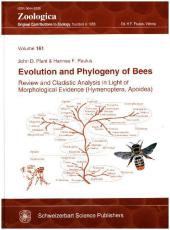 Neuerscheinungen 2016Stand: 2020-02-01 |
Schnellsuche
ISBN/Stichwort/Autor
|
Herderstraße 10
10625 Berlin
Tel.: 030 315 714 16
Fax 030 315 714 14
info@buchspektrum.de |

Hannes F. Paulus, John D. Plant
(Beteiligte)
Evolution and Phylogeny of Bees
Review and Cladistic Analysis in Light of Morphological Evidence ( Hymenoptera, Apoidea)
2016. 364 S. 232 Abb., 49 Tabellen. 310 mm
Verlag/Jahr: SCHWEIZERBART´SCHE VERLAGSBUCHHANDLUNG 2016
ISBN: 3-510-55048-X (351055048X)
Neue ISBN: 978-3-510-55048-7 (9783510550487)
Preis und Lieferzeit: Bitte klicken
Volume 161 of Zoologica reviews and analyses the evolution and phylogeny of bees. It is subdivided into two parts Part One: A Preamble to the Evolution and Phylogeny of Bees provides a complete and critical review of all previous attempts to reconstruct the phylogenetic tree of bees (Anthophila / Apiformes) based on morphological, bionomic and molecular approaches and pre- sented in chronological sequence up to and including recent publications. At the same time, the introductory part examines trends in the classification of bees and compares available hypotheses of bee evolution. Part One closes with a family-wise delineation of the fossil history of bees. Part Two: A Phylogenetic Study of Bees in Light of Morphological Evidence adds an experimental study to complement the bibliographical analysis provided in Part One. The phylogenetic relationships of the larger taxonomic units of bees are tested anew using an extensive dataset of selected morphological features. The study uses all common and current computer-aided techniques of cladistic analysis (parsimony, successive/implied weight, Bayesian and neighbor-joining), which are applied to representatives of all seven families, 22 subfamilies and 48 of 58 tribes of bees. The conclusions drawn from this are evaluated for the major groups (i.e., short-tongued and long-tongued bees), and separately for the families, subfamilies and tribes in each case. In a world currently dominated by molecular genetic approaches to phylogeny, this study clearly demonstrates that it is not anachronistic to engage in morphological efforts, because progress can be significantly advanced and the pool of available scientific arguments enriched. The diversity of the object of investigation justifies a variety of methods. This monograph is a much needed reference work of high practical value for all students of bee evolution, phylogeny and morphology. Further, it is ideally suited as good introductory reading material for university level students.


